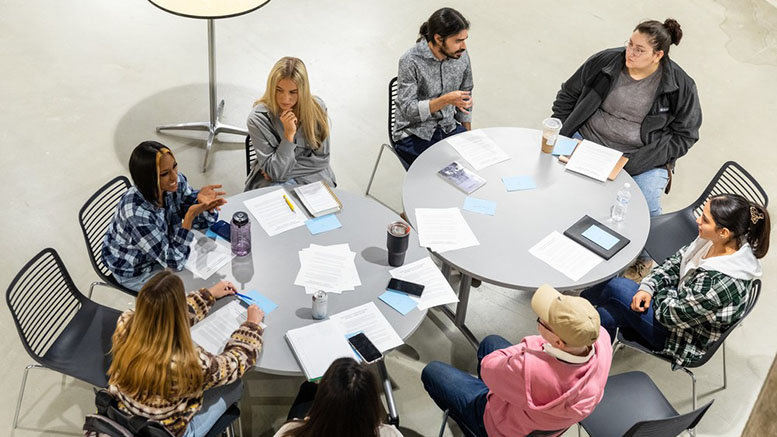Humanities and liberal arts, in general, are often common targets in discussions about the value of higher education, especially when it comes to college costs, career preparation and workforce development.
But supporters of the programs argue that they develop and strengthen important skills such as critical thinking — which are crucial in the workforce — and provide a deeper understanding of society. A confluence of pathways, programs and partnerships are reinforcing the value of critical reading, writing and discussions in an increasingly diverse and disruptive world.
In many instances, community college faculty are leading the way, with support from administrators and grant-making institutions: together they are helping students understand that their professional aspirations are not divorced from traditional subjects like history, philosophy, literature and composition. In fact, there is growing recognition that these subjects are more relevant than ever.
Related article: Humanities education quantified
“Constantly focusing on workforce development risks overshadows the role of college in creating quality human beings, individuals who can read think, and write critically,” says Jason Vinson, dean of liberal arts at Grand Rapids Community College (GRCC) in Michigan. “That’s at least as important.”
Vinson points to AI as an example: “It has crystallized what it means to be human: to ask difficult questions, to consider the ethics and principles that help us live in peaceful co-existence. AI is a tool,” he reminds students. “How do we use it responsibly? That’s humanistic inquiry.”
Working on transfer issues
One challenge for students taking liberal arts classes at community colleges may be a potential loss of some credit hours if they transfer to a four-year university. GRCC is a participant in Michigan’s statewide initiative, known as MiHumanities, that strives for greater coordination and coherence in liberal arts curricula by increasing transferable humanities course credits.
Through GRCC’s Humanities, English, Language, and Communication Studies Academic Pathways, students consider career possibilities in public relations, human resources, law, editing, writing and journalism, while benefiting from more transferable humanities credits. Similar pathways exist for English literature, French, Spanish and philosophy.
Vinson observes: “What’s interesting to watch is how studying the humanities actually helps students design their own lives. By exploring the past and talking about it, they become more intellectually curious about the present, about their own minds and the decisions they make.”
Life’s bigger questions
At Austin Community College (ACC) in Texas, associate professor of government Ted Hadzi-Antich, Jr., likes to emphasize the questions students ask of themselves beyond career-pathing. He employs the Socratic method of humanistic inquiry in his classes, opening with Plato’s Apology (“The Defense of Socrates”) as an overture to help students recognize the multitude of life’s most pressing questions and to encourage their pursuit of clarity.
“The Great Books are humbling,” notes Hadzi-Antich, “and community colleges provide an ideal environment for discussing what they can teach us. Our class sizes tend to be small, which allows space for meaningful classroom discussion that often extends outside of the class period.”
Hadzi-Antich is one of the founders of the Great Questions Seminar at ACC, supported by a grant from the Teagle Foundation. Great Questions employs the principles of liberal education for discussion-based study of transformative texts and the persistent human questions they raise: How do we know what we know? What is “a good life?” What is justice? What is beauty? What is the best form of government? Who am I? Where am I going, and what difference does it make?
Approximately 3,600 students have completed the course, and more than 125 faculty have been trained to teach the course on other community college campuses. Hadzi-Antich does not consider reconstitution of the humanities to be in conflict with transference but rather a rounding out the student trajectory.
As for the old trope about STEM vs. humanities, he explains that hard sciences like math and biology are hardly antithetical to the liberal arts: after all, theorems and hypotheses are all about asking how we know what we know.
Neither is Hadzi-Antich as concerned as some of his peers about the impact of AI on liberal education: “AI can’t sit in a chair in discussion with other students talking about what knowledge means to them personally,” he says. “At least not yet.”
ACC’s Great Questions Seminar was mentioned in a recent Wall Street Journal article about how The Great Books can help heal divided campuses by bringing students of different backgrounds together to discuss the big questions posed by the humanities.
Infusing the humanities into STEM
Helping students to learn about the human condition — modes of exchange, conversation and tolerance for differing views — is part of what drives English professor Andrew Rusnak at the Community College of Baltimore County (CCBC) to collaborate with his non-humanities colleagues to “contextualize and infuse” the humanities into biology, environmental science, nursing and engineering curricula.
Through grant support from the Mellon Foundation and the National Endowment for the Humanities, CCBC has enabled faculty from various disciplines to collaborate on content that considers math, science, allied health, criminal justice and engineering in a more humanistic way. Faculty from these disciplines are happy to participate: integrating humanistic questions brings a new and different kind of energy to the classroom.
“You can feel it,” Rusnak says. “From K-12, all these students did was read a chapter, listen to a lecture and take a test. They learned to rely on rote memory as their primary cognitive skill to get through school. Now they are being asked to consider the application of their knowledge in real life, develop a point of view and express their own ideas.”
The idea that STEM and the humanities are engaged in battle is unhelpful for students and society, he says.
“We’ve lost the cultural message. Why do we go to college? It’s not just for utilitarian reasons. We want to be critically responsible, thinking human beings who can participate in civic society,” Rusnak says.

